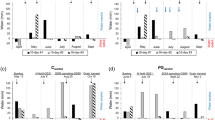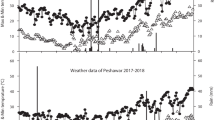Abstract
Nitrogen use efficiency (NUE) of tef, a major staple crop in Ethiopia, is very low, either caused by untimely use of nitrogen (N) fertilizers or lack of other essential nutrients like sulphur (S). The average grain yield of this crop is low, averaging <0.8 Mg ha−1 in farmer’s fields of the semi-arid conditions. Therefore, the present study was conducted to see the effect of the timing of combined N and S fertilization on the yield, yield components, and N and S concentration in the plant parts of the crop. A factorial combination of three rates of N (0, 70, and 105 kg ha−1) with four rates of S (0, 16, 32, and 48 kg ha−1) was applied in randomized complete blocks in three replications. The experiment was carried out in the 2004 and 2005 cropping seasons in the Cambisols of the semi-arid area of Ethiopia. The crop responded significantly (P < 0.05) to both split (one-third at planting and two-thirds at late tillering) and whole (all at planting) N and S applications and years. Combined N and S fertilization increased the dry matter (DM) and grain yields on average by 1.7 and 0.3 Mg ha−1, compared with the control. Similarly, S fertilization increased the NUE of the tef crop by 36%. Nitrogen concentration of shoots was found to significantly increase with S application (P < 0.05), with strong positive interactions both in the split and whole applications. The sulphur increase in grains was significant with N rates for both applications, with significant interaction effects observed for the split application in both cropping seasons. Split application resulted in 0.9 and 0.3 Mg ha−1 significant increase in DM and grain yields, averaged for both years and treatments compared with the whole application. Similar significant increases were observed for panicle yield, NUE, and shoot and grain N and S concentrations. The average N:S ratio in grains was 10.6:1. Significant (P < 0.05) yearly variations were also observed. Dry matter and grain yields of 2005 were higher on average by 2.10 and 0.32 Mg ha−1 than those of the 2004 cropping season. The percentage of N and S concentrations of grains, averaged for both applications, were higher by 13 and 9% in 2004; even though the N and S uptakes of 2005 were higher on average by 5.0 and 0.5 kg ha−1 than those of the 2004 cropping season. This work showed that the yield response and NUE of the tef crop could be improved with split N and S fertilizer applications, with tef-producing farmers benefitting from the application of S-containing N fertilizers to soils deficient in these nutrients.
Similar content being viewed by others
References
Ahmad A, Abdin MZ (2000) Photosynthesis and its physiological variables in the leaves of Brassica genotypes as influenced by sulphur fertilization. Physiol Plant 110:144–149
Ahmad A, Abdin MZ, Khan I, Anjum NA, Diva I, Muhammad I (2005) Effect of timing of sulphur on growth and yield of rapeseed. J Plant Nutr 28:1049–1059
Alcoz MM, Hons FM, Haby VA (1993) Nitrogen fertilization timing effect on wheat production, nitrogen uptake efficiency, and residual soil nitrogen. Agron J 85:1198–1203
Anderson JW (1990) Sulphur metabolism in plants. In: Miflin BJ, Lea PJ (eds) The biochemistry of plants, vol 16. Academic Press, New York, pp 327–381
Asrat W, Frew T (2001) Utilization of tef in the Ethiopian diet. In: Hailu T, Getachew B, Mark S (eds) Narrowing the rift. Tef research and development. Proceedings of the International Workshop on Tef Genetics and Improvement, 16–19 October 2000, DebreZeit, Ethiopia, pp 239–244
Balesh T, Zapta F, Aune J, Situala B (2005) N fertilization, soil type and cultivars effects on N use efficiency in tef (Eragrostis tef (Zucc.) Trotter). Nutr Cycl Agroecosyst 71:203–211
Bremer JM, Mulvaney CS (1982) Total nitrogen. In: Page AL, Miller RH, Keeny DR (eds) Methods of soil analysis. II. Chemical and microbiological properties, agronomy monograph, No. 9, 2nd edn. SSSA, Madison, pp 595–622
Ceccotti SP (1996) Plant nutrient sulphur—a review of nutrient balance, environmental impact and fertilizers. Fertil Res 43:117–125
Costanza SH, DeWet JM, Harlan JR (1979) Literature review and numerical taxonomy of Eragrostis tef. Econ Bot 33:413–424
FAO/UNESCO (1977) Soil map of the world, vol 6. Africa. UNESCO, Paris, xiv, p 299
Flaete NES, Hollung K, Ruud L, Sogn T, Faergestad EM, Skarpeid HJ, Magnus EM, Uhelen AK (2005) Combined nitrogen and sulphur fertilization and its effect on wheat quality and protein composition measured by SE-FPLC and proteomics. J Cereal Sci 41:357–369
Hocking PJ (1994) Dry matter production, mineral nutrient concentration and nutrient distribution and redistribution in irrigated spring wheat. J Plant Nutr 17:1289–1308
Inal A, Gunes A, Alpaslan M, Adak MS, Taban S, Eraslan F (2003) Diagnosis of sulphur deficiency and effects of sulphur on yield and yield components of wheat grown in central Anatolia, Turkey. J Plant Nutr 26:1483–1498
Itanna F (2005) Sulphur distribution in five Ethiopian Rift Valley soils under humid and semi arid climate. J Arid Environ 62:597–612
Knudsen D, Peterson GA, Pratt PE (1982) Lithium, sodium and potassium. In: Page AL, Miller RH, Keeny DR (eds) Methods of soil analysis. Part 1. Chemical and microbiological properties, agronomy monograph, No. 9, 2nd edn. SSSA, Madison, pp 225–246
Lopez-Bellido L, Lopez-Bellido RJ, Redondo R (2005) Nitrogen efficiency in wheat under rainfed Mediterranean conditions as affected by split nitrogen application. Field Crops Res 94:86–97
Ministry of Agriculture and Rural Development (MARD) (2005) Fertilizer inputs in Ethiopia. Ethiopia Addis Ababa, p 10
Mukhopadhyay AK, Mukhopadhyay P (1995) An overview of sulphur research in soils of west Bengal, India. Sulphur Agric 19:30–34
Nelson DW, Sommers LE (1982) Total carbon, organic carbon, and organic matter. In: Page AL, Miller RH, Keeny DR (eds) Methods of soil analysis. I. Chemical and microbiological properties, agronomy monograph, No. 9, 2nd edn. SSSA, Madison, pp 539–579
Olsen SR, Sommers LE (1982) Phosphorus. In: Page AL, Miller RH, Keeny DR (eds) Methods of soil analysis. I. Chemical and microbiological properties, agronomy monograph, No. 9, 2nd edn. SSSA, Madison, pp 403–430
Paar A (1998) Multiwave microwave sample preparation system instruction handbook. Paar, Graz
Peoples MB, Beilharz VC, Waters SP, Simpson RJ, Dalling MJ (1980) Nitrogen redistribution during grain growth in wheat (Triticum aestivum L.). II. Chloroplast senescence and the degradation of ribulose-1,5-biphosphate carboxylase. Planta 149:241–251
SAS Institute (2002) SAS user’s guide: statistics. Statistical Analysis System Institute, Cary
Schung E, Haneklaus S, Murphy D (1993) Impact of sulphur fertilization on fertilizer nitrogen efficiency. Sulphur Agric 17:8–12
Seyfu K (1983) Studies of lodging floral biology and breeding techniques in tef (Eragrostis tef (Zucc.) Trotter. PhD Thesis submitted to the University of London, Royal Holloway College, UK
Stabursvik A, Heide OM (1974) Protein content and amino acid spectrum of finger millet (Eleusine coracana (L.) Gaertn.) as influenced by nitrogen and sulphur fertilizers. Plant Soil 41:549–571
Taddesse E (1969) Tef (Eragrostis tef): the cultivation usage, and some of the known diseases and insect pests. I. Debreziet agricultural experimental station bulletin No. 60. Hail sellassie I University, College of Agriculture, DireDawa, Ethiopia
Tandon HLS (1991) Sulphur research and agricultural production in India, 3rd edn. Sulphur Institute, Washington, p 140
Zhao FJ, Hawkesford MJ, McGrath SP (1999) Sulphur assimilation and effects on yield and quality of wheat. J Cereal Sci 30:1–17
Acknowledgements
The authors duly acknowledge the CND (Combating Nutrient Depletion) project funded by the Ministry of Foreign Affairs, Norway, and Mekelle University for partially funding this study. The first author also appreciates the financial support received from the Loan Bank (Lånekassen, Norway).
Author information
Authors and Affiliations
Corresponding author
Rights and permissions
About this article
Cite this article
Habtegebrial, K., Singh, B.R. Effects of timing of nitrogen and sulphur fertilizers on yield, nitrogen, and sulphur contents of Tef (Eragrostis tef (Zucc.) Trotter). Nutr Cycl Agroecosyst 75, 213–222 (2006). https://doi.org/10.1007/s10705-006-9028-8
Received:
Accepted:
Published:
Issue Date:
DOI: https://doi.org/10.1007/s10705-006-9028-8




